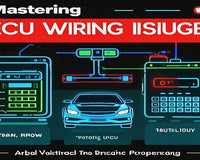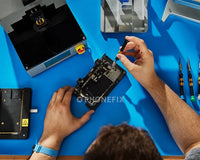ECU is the brain of your vehicle, managing everything from fuel injection to ignition timing. When your car starts acting up—sputtering, stalling, or throwing error codes—the ECU is often a suspect. While professional diagnostic tools are ideal, a multimeter can be a handy ally for basic ECU tests.
Before diving into the testing process, gather these essential tools and take some key precautions:
Digital Multimeter: Opt for one with auto-ranging capabilities and settings for DC voltage, resistance (ohms), and continuity. A quality DMM ensures accurate readings, which is crucial for diagnosing ECU issues.
Service Manual for Your Vehicle: This is non-negotiable. It contains the ECU’s pinout diagram, which details which wires correspond to specific functions (e.g., power, ground, sensors).
Basic Hand Tools: Screwdrivers (flathead and Phillips), pliers, and possibly a socket set to remove the ECU housing or access its connectors.
Safety Gear: Gloves to protect your hands from sharp edges, and safety glasses in case of loose debris.
Battery Disconnect Tool: To safely disconnect the car battery before handling ECU connectors—this prevents short circuits and protects both you and the ECU.
Step-by-Step: Testing the ECU with a Multimeter.
Before testing, check for corrosion, loose wires, burnt connectors, or water damage. These issues can cause ECU malfunctions and should be addressed first.
1. Remove the ignition key from your car and turn it off.
2. It's usually near the engine where you'll find the ECU. Your car may have a single or two connectors for connecting the battery to the ECU.
3. The negative battery terminal should be connected to the black probe of the multimeter, and the positive terminal to the red probe.
4. Set the voltage reading on the multimeter.
5. after starting your car, let it run.
6. Use a multimeter to measure the voltage. it should be in the range of 12 to 16 volts. Your ECU needs to be replaced if it shows a voltage reading outside this range. If the voltage reading is normal, shut off the engine and disconnect the battery so you can safely reassemble all removed components.
If your car has a check engine light, use V519 OBD-II scanner to clear codes after fixing issues. Some problems (like a loose ground) may resolve immediately, while others may require further diagnosis.
Testing an ECU with a multimeter is a practical way to rule out common electrical issues like weak power or bad grounds. If your multimeter tests show normal power and grounds, but the car still misbehaves, it’s time to consult a mechanic with professional diagnostic equipment. They can perform advanced tests like checking ECU software or conducting a full system scan.
Remember: safety comes first—always disconnect the battery before handling electrical components, and don’t hesitate to seek professional help for complex problems. Happy troubleshooting!
How to Test an ECU with a Multimeter: A Step-by-Step Guide










